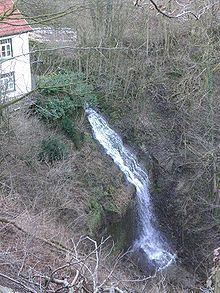Elevation 440 m Country Germany | Length 10 km | |
 | ||
Mittelgebirge in deutschland teil 3 s ntel mit hohe egge und hohenstein
The Süntel is a massif in the German Central Uplands that is up to 437.5 m above sea level (NN). It forms part of the Weser Uplands in Lower Saxony southwest of Hanover and north of Hamelin.
Contents
- Mittelgebirge in deutschland teil 3 s ntel mit hohe egge und hohenstein
- Map of SC3BCntel 31848 Bad MC3BCnder Germany
- Kleines bushcraft treffen im s ntel
- Geographical location
- General
- Features
- History
- Flora and fauna
- Economy and tourism
- Hills
- Valleys
- Towns and villages
- Inns
- Literature
- References
Map of S%C3%BCntel, 31848 Bad M%C3%BCnder, Germany
Kleines bushcraft treffen im s ntel
Geographical location
The Süntel is the eastern extension of the Wesergebirge and runs for about 12 km from northwest to southeast. It is surrounded by the valleys of the Aue, Deister-Süntel and Weser. It is also part of the Weser Uplands Schaumburg-Hamelin Nature Park and the Calenberg Uplands. The Hohenstein hill and its immediate vicinity are a nature reserve.
General
The southeastern part of the Süntel, including the Hohe Egge, consists mainly of Wealden sandstone from the Lower Cretaceous period as well as small anthracite deposits. Its northwestern part, including the Hohenstein with its 350 m long and 50 to 60 m high crags, comprises limestone of the Upper Jurassic period, the Corallian oolith.
Features
The main geological features of the Süntel are:
History
Flora and fauna
The Süntel is covered by mixed woods which are dominated by beech, but also has other species such as oak, spruce, hornbeam and coast Douglas-fir and rarer types like the yew and wild service tree. A botanic rarity is the dwarf beech (known in German as the Süntel-Buche or "Süntel beech") of which there are about a dozen old examples still in the Süntel (at Dachtelfeld and Bleeksgrund). The last great dwarf beech wood on the Westeregge was almost completely cleared in 1843. In addition there are numerous, rare species of flower such as varieties of Primula, spring snowflake, horseshoe vetch, hart's-tongue fern, spleenwort, lady's slipper, heath spotted orchid, etc.
In addition to roe deer and wild boar there are also mouflon wild sheep in the Süntel. Rarer sights are the barn owl, kestrel, black woodpecker and pine marten. The black stork is occasionally seen on the southern slopes.
Economy and tourism
In addition to forestry and tourism quarrying plays an important role in the Süntel. Süntel sandstone was used for many notable buildings in the area such as the Rat Catcher's House in Hamelin, Barntrup Castle, Schwöbber Castle and Hämelschenburg Castle. Limestone from the quarries near Pötzen, Segelhorst, Langenfeld and Hamelspringe is used in road construction. The town of Münder had a coal mine in the Süntel that operated for about half a century from 1809.
In the Süntel, as well as hiking trails with views over the valleys, there are also long, straight, rather monotonous forest tracks without any signs. The Hohenstein crags provide a training ground for rock climbers and mountaineers.
Hills
The main hills and elevations of the Süntel are – with heights in metres above Normalnull (NN):
Valleys
The valleys of the Süntel include the:
Towns and villages
The towns and villages of the Süntel include:
Inns
The forest restaurants in and around the Süntel include the:
